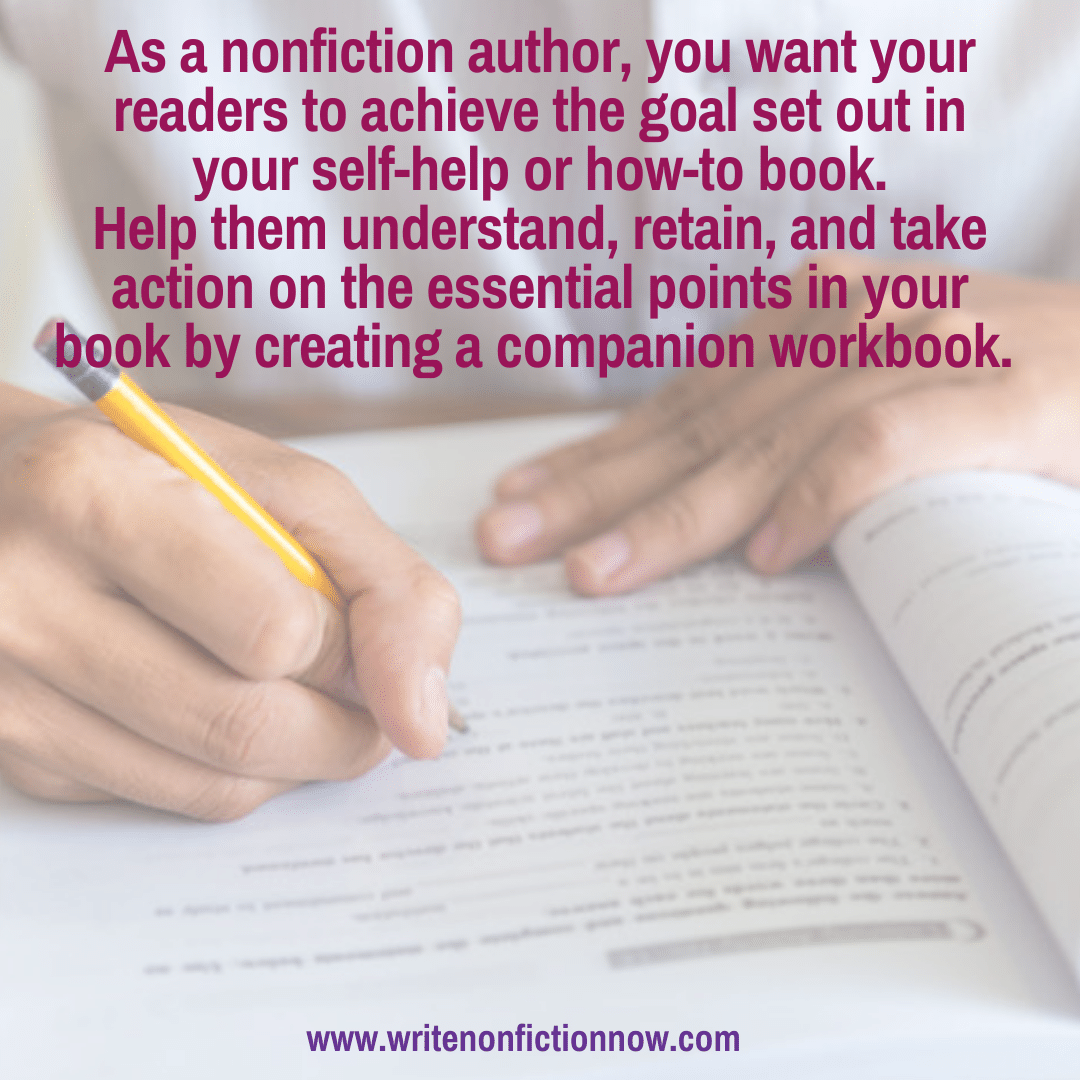Wednesday, December 15, 2021

Sometimes, readers need more than a book to take consistent and concrete steps toward a goal. That’s where a workbook comes into play. Today,
Jay Artale (
@BirdsOAFpress) provides foundational information on how to turn your nonfiction book into a companion workbook to support readers.
If you’re planning to write a self-help or how-to book, producing a companion workbook benefits your audience and you. Workbooks help your audience make a connection between the knowledge you’ve shared in your book and apply it to their personal experiences and goals. It helps them take action on the principles in your book. And, since your workbook is an additional product to sell, you stand to increase your books sale income—from both the original book and the workbook.
Providing a workbook helps your audience identify and retain the most essential information in your self-help or how-to book. It’s much easier to learn by doing, and your workbook facilitates that learning experience. Learning something new can be an overwhelming process, but a workbook breaks down a multi-step process into manageable-sized chunks.
Some readers are disciplined or structured enough to read a book and work through the different tasks and assignments. Others want their hands held every step of the way.
Two Steps to Workbook Creation
It’s not hard to create a workbook. In fact, you can create a workbook in two simple steps.
First, plan your workbook content by including and asking readers to take the action steps as they appear in your book. Second, as you design the workbook, leave space for your readers to document their answers.
If you are still wondering what type of content to include in your workbook, here are some suggestions to help you make that decision.
Goals and Intentions
According to a study done by Dr. Gail Matthews, a clinical psychologist from Dominican University of California, you are 62 percent more likely to achieve your goals when you write them down.
Writing an intention is a lot more powerful than just thinking about it. Therefore, it’s a good idea to start any workbook with an opportunity for your readers to establish their goals and state their intentions.
Readers may have a clear idea about what they’re trying to achieve, But if not, this section is an excellent opportunity to set expectations and clarify where they’re heading.
Questions
If your book poses questions, the most straightforward workbook pages list the questions and leave enough space for readers to write free-form responses. These questions may require yes or no answers or a quick paragraph in response. Or, you might include a question that takes some soul searching or in-depth thought process to answer. If there’s a shortlist of potential answers, you could also provide a checklist option.
Remember, some readers may want to doodle or draw small diagrams in addition to their written responses. Therefore, it’s always a good idea to allow more space than you think they may need. Keep in mind that you’re more familiar with the content than them. Thus, they may have a longer or more difficult journey to get to where they want to be.
Worksheets
If your book involves walking through a multi-step decision-making process, a worksheet can keep readers on track and help them to avoid feeling overwhelmed.
I created multiple standalone worksheets for my self-publishing series to help guide my readers through some complex decisions. I use these worksheets as a marketing and promotion tool to help build my mailing list.
If the thought of creating a workbook is too overwhelming, then a series of worksheets is a good stepping stone in the creation process.
Lists
There are a variety of lists you can include in your workbook. For instance, you can:
- Provide a topic and direct your readers to create their own list.
- Provide lists of resources or options. These help your readers focus on what’s important and move them forward a lot quicker.
- Create a pro and cons list template to help your readers work through a decision-making process.
- Provide a checklist of every step they need to achieve, which creates a transparent action list.
Timeline or Schedule
Providing a timeline for taking action steps helps your reader set realistic expectations. The same is true when you help them establish a schedule for reaching your book’s goal in a timely manner.
You can provide suggestions on how long a specific task should take and then give them a way to track their time spent on the task. Or provide a daily or weekly schedule to help them manage their time as they move through the tasks or steps provided in your workbook and book.
Additional Workbook Considerations
As well as the content ideas mentioned, there are additional considerations to keep in mind when creating a workbook.
For instance, although workbook structure is important, provide some flexibility within your format to allow your readers to capture thoughts and ideas about their learning experience. For example, add a short prompt as a leading question to trigger this thought process or leave space for them to fill in their free-form content or sketches.
I like to think of workbooks as a steppingstone in the content creation chain. For example, your blog posts can lead to a book. Then, your book can spawn a workbook. After that, your workbook can become the basis for an online course.
Workbooks are an obvious way to leverage your existing content and help you build an audience. They’re also a great marketing tool for selling or giving away at your speaking engagements.
Your book’s niche and subject matter determine the type of content you provide in your workbook. In fact, some topics lend themselves more readily to a workbook than others. However, workbooks should have two things in common: a lack of ambiguity and an abundance of clarity.
Your workbook needs to help your readers, not hinder them. Your content needs to have a cohesive flow, with one section leading seamlessly to the next. As readers complete the workbook, they should consistently move toward achieving whatever goal you discuss in your book.
Do these things, and you’ve created a solid and helpful workbook. Plus, you’ll offer your readers tremendous benefit and support.
Have you created a workbook? Tell me about your experience. And please share this post with a friend.
About the Author
Jay Art ale abandoned her corporate career to become a digital nomad and full-time writer. She’s an avid blogger and a nonfiction author helping travel writers and travel bloggers achieve their self-publishing goals. Join her at Birds of a Feather Press where she shares tips, advice, and inspiration to writers with an independent spirit.
ale abandoned her corporate career to become a digital nomad and full-time writer. She’s an avid blogger and a nonfiction author helping travel writers and travel bloggers achieve their self-publishing goals. Join her at Birds of a Feather Press where she shares tips, advice, and inspiration to writers with an independent spirit.
 Do you want to learn more about becoming a successful nonfiction author? Check out the Nonfiction Writers’ University. Get the education and coaching to help you succeed as a nonfiction writer. Take advantage of monthly live group author coaching, and gain access to an extensive archive of educational resources, like interviews with experts, challenges, homework assignments, courses, and ebooks. If you’ve wanted one place to go for all your nonfiction writing and publishing needs, this is it. And if you’ve wished you could purchase Nina Amir’s best courses or hire her as your author coach, now you can…for a small monthly investment. Enjoy a 30-day trial membership for only $1.
Do you want to learn more about becoming a successful nonfiction author? Check out the Nonfiction Writers’ University. Get the education and coaching to help you succeed as a nonfiction writer. Take advantage of monthly live group author coaching, and gain access to an extensive archive of educational resources, like interviews with experts, challenges, homework assignments, courses, and ebooks. If you’ve wanted one place to go for all your nonfiction writing and publishing needs, this is it. And if you’ve wished you could purchase Nina Amir’s best courses or hire her as your author coach, now you can…for a small monthly investment. Enjoy a 30-day trial membership for only $1.
Photo courtesy of mukphotos.
Nina Amir, the bestselling author of How to Blog a Book and The Author Training Manual, is a speaker, a blogger, and an author, book, blog-to-book, and high-performance coach. Known as the Inspiration to Creation Coach, she helps creative people combine their passion and purpose so they move from idea to inspired action and positively and meaningfully impact the world as writers, bloggers, authorpreneurs, and blogpreneurs. Some of Nina’s clients have sold 300,000+ copies of their books, landed deals with major publishing houses and created thriving businesses around their books. She is the founder of National Nonfiction Writing Month, National Book Blogging Month, and the Nonfiction Writers’ University. As a hybrid author she has published 19 books and had as many as four books on the Amazon Top 100 list at the same time. Her most recent book is called Creative Visualization for Writers, and tomorrow her 19th book will be released, The Write Nonfiction NOW! Guide to Creativity and Flow. Find all her books at booksbyninaamir.com or find out more about her at ninaamir.com.